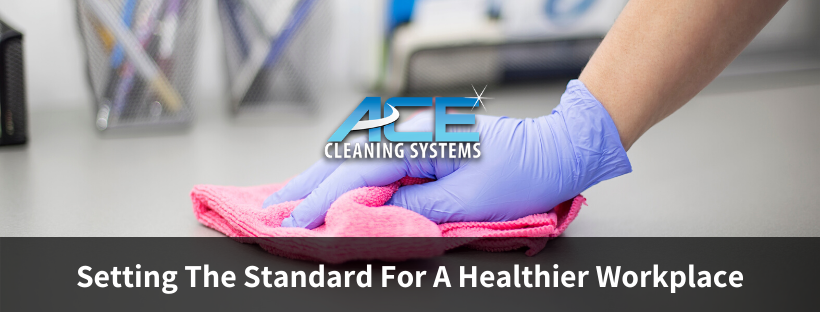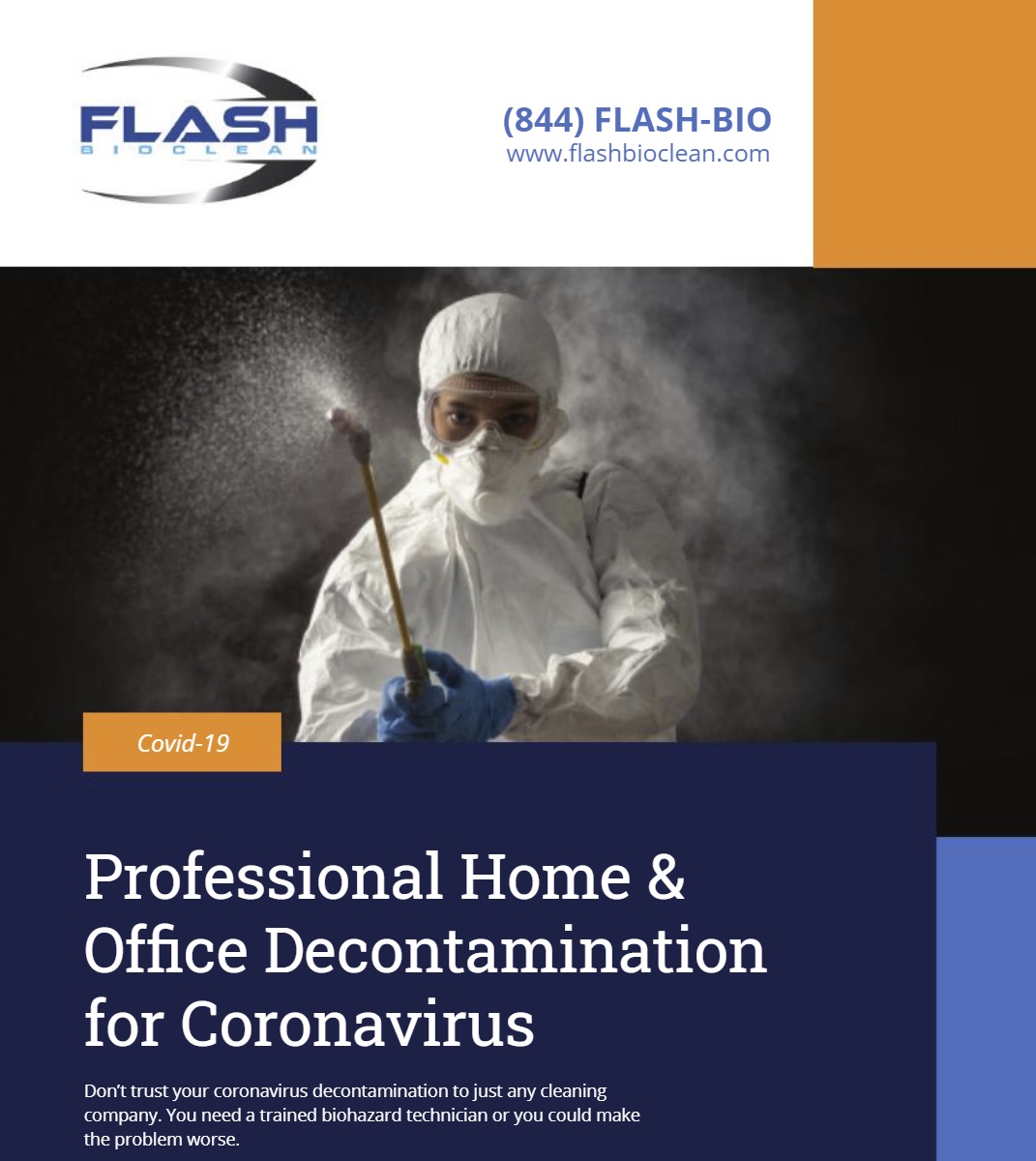A Healthy Workplace Starts In the Janitor’s Closet by ACE Cleaning Systems
A Healthy Workplace Starts In the Janitor’s Closet
Is Your Workplace Healthy?
We all want to live and work in a safe and sanitary environment. In light of the recent covid-19 outbreak, we have become more aware of the importance of cleaning (and disinfecting) the surfaces we touch in our workplaces. While no facility can be made “germ free”, janitorial companies can utilize modern cleaning and disinfection practices to create a safe and healthy work environment for your business.
Much of the equipment and cleaning practices in current use have become outdated because they are less effective at removing germs. This is because science has uncovered three disturbing facts:
1. Surfaces that look clean are not always free of germs.
2. Cleaning incorrectly can actually cause germs to spread from one area to another.
3. Certain types of cleaning equipment and supplies actually encourage the spread of germs.
The important takeaways are this: surfaces that look clean can still contain enough germs to cause an illness to spread. And, even though it may look like someone is cleaning and disinfecting your facility, they may unknowingly be spreading germs around because they aren’t using the right cleaning methods and or equipment.
So, how can you know if your cleaning company is removing sufficient amounts of germs from the surfaces they clean? First, inspect the janitor’s closet for outdated commercial cleaning equipment and supplies.
What’s in your janitor’s closet?
A janitorial closet that is well organized and kept clean provides a clue that your janitorial company is doing its job properly. But, the type of equipment and supplies you find inside your closet can uncover the real reason you’re not reducing employee absenteeism.
Is your janitor closet unorganized? Are bottles not labeled? Are rags thrown all over the place? Do you see dirty string mops and contaminated buckets? Is there a “dirty” laundry bag to keep new and used towels separated? Does you company have disposable microfiber towels in the event your workplace has reported sick employees?
Look in your janitor’s closet for three signs of inadequate disinfection and or cross contamination(i.e. the spread of germs):
1. String mops and buckets – There are very few uses for string mops in outpatient healthcare facilities. String mops can spread massive amounts of germs around (see study below) when used for routine floor cleaning. String mops can be replaced with inexpensive, EPA recommended, bucket-less flat mops that virtually eliminate cross contamination (see the UC Davis study on flat mops vs. string mops here).
2. Soiled rags, wet string mops, buckets with standing water should not be found lying around or hanging in your janitor’s closet (they are breeding grounds for germs). Soiled cleaning cloths and mop heads should be stored in closed containers and laundered properly after each use. Cleaning cloths and mop heads should not be hand washed on-site and re-used.
3. Find out the name of the disinfectant your cleaning company is using (please look in your janitor’s closet). Every chemical in the closet should be labeled (OSHA regulations) and should have a corresponding safety data sheet (SDS). The cleaning company should be using a disinfectant that has been approved by the EPA for use against the coronavirus. The list can be found here:
https://www.epa.gov/pesticide-registration/list-n-disinfectants-use-against-sars-cov-2
Cleaning Best Practices:
Best practices are defined as commercial procedures that are accepted as being correct or most effective. Best cleaning practices have been developed in the janitorial industry through research by leading authorities in the field. These practices include the use of certain types of equipment, supplies and cleaning methods and when followed, produce high quality results.
Cleaning Standards:
So, how can you know if your janitorial company’s equipment can reduce employee absenteeism and protect the health of your staff? It’s really not hard to find out. Just follow the checklist we’ve created for you below. This list is not arbitrary. Its based on accepted cleaning standards that have been developed after years of research by highly respected organizations such as:
the EPA, CDC, and USGBC (United States Green Building Council).
The cleaning standards developed by these organizations are widely accepted as janitorial cleaning best practices. But, unfortunately, they aren’t always practiced. Commercial cleaning companies often use outdated, ineffective equipment that just can’t get the job done properly.
Janitorial Closet Checklist:
The equipment checklist below is your best defense against hiring the wrong cleaning company and keeping your workplace safe and healthy. Ask these questions before you sign your next janitorial cleaning contract:
1) Do you use string mops?
If they answer yes, this is a big red flag. Many companies still use outdated string mops that spread dirt and germs around. Microfiber flat mops are a better choice and an accepted standard.
Read more about the best mops to use in healthcare and most commercial facilities:
https://www.acecleaningsystems.com/single-post/The-Best-And-Worst-Mops-For-Commercial-Cleaning
2) Do you dilute chemicals by hand?
Many companies still dilute cleaning solutions by hand. Manual methods of dilution are unreliable and can be dangerous. Automated dilution systems are the cleaning standard today.
3) Are all bottles labeled according to OSHA standards?
OSHA requires labeling on all cleaning products to prevent improper use. This is for the safety of your building’s occupants. Is the company OSHA compliant?
4) Do you use green clean certified products?
Green cleaning products are safe and non-toxic. They are not required, but are becoming an accepted standard in many facilities.
5) Do you use microfiber towels?
Microfiber towels are the accepted standard for surface cleaning and disinfection. Paper towels and cotton rags cannot remove dirt or soil as effectively and are out of favor. Many companies use paper towels to avoid using microfiber towels that require ongoing laundering services. To minimize the spread of infections janitorial companies should endorse disposable microfiber towels.
6) Do you use a color-coded system for towels?
Color-coded towel systems prevent the spread of germs from one area of your facility to another. You don’t want a janitorial worker using the same towel to clean your bathroom and desk. Color-coding prevents this from happening.
7) Do you use HEPA certified vacuums?
HEPA certified vacuums capture very fine dust particles. They improve indoor air quality and remove more soil than other vacuums. This is an accepted cleaning standard, especially in hospitals, medical offices, schools and child care centers. Many cleaning companies use in-expensive, less effective vacuums. Poor air quality has been associated with headaches, fatigue, trouble concentrating, irritation of the lungs and other health issues, according to the U.S. Department of Labor’s Occupational Safety and Health Administration (OSHA). Read more about how to increase the indoor air quality in your workplace:
https://www.cleanlink.com/cp/article/High-Vacuuming-Improves-Indoor-Air-Quality–23910
8) Will you be using EPA registered, hospital grade disinfectants?
There are many disinfectants available for purchase over the counter. However, the accepted standard and more effective practice is to use commercially available, EPA registered disinfectants.
9) Do you use a laundry system to clean and disinfect towels and rags?
If a janitorial company doesn’t have a separate laundry bag for used towels, it’s another red flag. Accepted standards include frequent changing of microfiber towels to prevent the spread of dirt and germs, aka cross contamination. After towels have become soiled, they should be stored in a “dirty” bag until laundered. This sounds like a simple process, but you’d be surprised how many cleaning companies don’t have a laundering system in place.
10) Do you have a disinfection plan if there is an outbreak in your workplace?
Electrostatic spray disinfection is a highly effective method of applying an EPA-registered disinfectant to surfaces and objects. The disinfectant is sprayed on electrostatically, causing it to cling and wrap around the surface or object, providing a more thorough and effective disinfection. Read more: https://www.acecleaningsystems.com/single-post/How-To-Reduce-the-Spread-of-Germs-at-Work
Commercial Janitorial Cleaning Services
Ace provides high quality commercial cleaning services to businesses in Boca Raton, Fort Lauderdale, Pompano Beach and nearby cities. Over the last 12 years our company has developed cost effective janitorial cleaning programs for a wide range of businesses in Broward and Palm Beach County. We are an independent, locally owned company with a hands on management team that is responsive to our customer’s needs.
Members of SFPMA – View our Membership page
Zach Shor
954-756-2588
President, Ace Cleaning Systems, Inc.
Tags: Building Maintenance, Management News, Member Highlights







 West Point Military Academy required a comprehensive structural assessment and exterior envelope renovation of the following buildings: Building 639, Water Treatment Plant, Scott Barracks, Eisenhower Barracks, The Fire House, and the Library Building. O&S Associates performed inspections and structural evaluation of the building’s exterior façade, roofs, and developed a repair program. O&S prepared repair drawings and technical specifications and made periodic observations of construction as part of construction management services.
West Point Military Academy required a comprehensive structural assessment and exterior envelope renovation of the following buildings: Building 639, Water Treatment Plant, Scott Barracks, Eisenhower Barracks, The Fire House, and the Library Building. O&S Associates performed inspections and structural evaluation of the building’s exterior façade, roofs, and developed a repair program. O&S prepared repair drawings and technical specifications and made periodic observations of construction as part of construction management services.







 Over the past few months, we’ve spoken with countless property managers in order to learn how to better serve the needs of our users. Many expressed concerns regarding a one log-in system to track all gate activity for both guests and residents. ZUUL Systems is just that: an all-in-one control system, database, and login that’ll take care of all your gate access control needs.
Over the past few months, we’ve spoken with countless property managers in order to learn how to better serve the needs of our users. Many expressed concerns regarding a one log-in system to track all gate activity for both guests and residents. ZUUL Systems is just that: an all-in-one control system, database, and login that’ll take care of all your gate access control needs.
